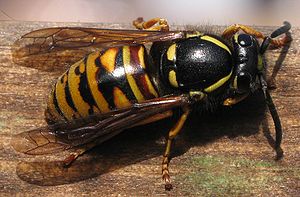Red wasp
| Red wasp | ||||||||||||
|---|---|---|---|---|---|---|---|---|---|---|---|---|

Red wasp ( Vespula rufa ) (queen) |
||||||||||||
| Systematics | ||||||||||||
|
||||||||||||
| Scientific name | ||||||||||||
| Vespula rufa | ||||||||||||
| ( Linnaeus , 1758) |

The red wasp ( Vespula rufa ) is a wasp species from the genus of the short-headed wasps ( Vespula ) and thus belongs to the real wasps (Vespinae). The red wasp is one of the closest relatives of the Germans ( Vespula germanica ) and the common wasp ( Vespula vulgaris ). In contrast to these, it avoids being close to people and does not eat their food. The red wasp is peaceful and is not considered a nuisance .
features
The two front abdomen segments of the otherwise yellow-black wasp are shown in red. In the queens , the red markings are often not very pronounced. The name of the species goes back to this coloration of the two anterior abdominal segments. The queens of the red wasp are sixteen to twenty millimeters long. The workers are significantly smaller at ten to fourteen millimeters. The drones reach body lengths of thirteen to sixteen millimeters. The drawing on the front plate (clypeus) is reminiscent of an arrowhead, but its characteristics are very variable. The red wasps are similar to the rare Norwegian wasp ( Dolichovespula norwegica ), a species of long-headed wasp .
distribution
The red wasp occurs in all of Europe with the exception of the extreme south, also in northern Asia, east to Kamchatka, Korea and Japan. The southern border of the distribution reaches Turkey, Azerbaijan, central China and Taiwan (it is absent in Iran). It is also found in northern North America, almost all of Canada, and some northern states in the United States. The populations from East Asia and North America differ in their coloration by predominantly ivory white instead of yellow.These color variants were described in North America as Vespula intermedia (du Buysson, 1905) and in East Asia as Vespula rufa schrenckii (Radoszkowski, 1861), but apply today than without taxonomic value. Similar colored animals are occasionally found in Scandinavia.
Way of life
nutrition
The adult animals ( Imagines ) feed mainly on nectar from parsley family and the honeydew of aphids . The larvae are fed with animal protein. For this purpose, mainly different types of flies and mosquitoes are captured and chewed to a pulp. The red wasps are only very rarely found in human settlements and do not go to human food.
General
Due to their diet, the red wasps are, in contrast to their close relatives the Germans and the common wasps, not pests. The nest is only defended if it comes to disturbances in the immediate nest area.
Life cycle
From mid-April, mated females, the queens, can be observed searching for nests and foraging. The nests are usually created underground in abandoned mole or mouse structures. The life cycle is relatively short and ends in early to mid-September. After the wasp colony died out, the mated females overwinter and found new colonies in the following year. A colony of the red wasp comprises around 150 to 350 animals and is therefore much smaller than the colony of the German and common wasps, which can contain several thousand individuals.
literature
- Rolf Witt: Observe wasps, determine . Naturbuch / Weltbild, Augsburg 1998, ISBN 3-89440-243-1
- Heiko Bellmann : bees, wasps, ants. Hymenoptera of Central Europe . Franckh-Kosmos, Stuttgart 1995, ISBN 3-440-06932-X
- Jirí Zahradnik : bees, wasps, ants. The hymenoptera of Central Europe . Franckh-Kosmos, Stuttgart 1985, ISBN 3-440-05445-4
Individual evidence
- ↑ James M. Carpenter & Jun-ichi Kojima (1997): Checklist of the species in the subfamily Vespinae (Insecta: Hymenoptera: Vespidae). Natural History Bulletin Ibaraki University 1: 51-92.
- ^ Matthias Buck, Stephen A. Marshall, David KB Cheung (2008): Identification Atlas of the Vespidae (Hymenoptera, Aculeata) of the northeastern Nearctic region. Canadian Journal of Arthropod Identification No.5. doi: 10.3752 / cjai.2008.05
- ↑ Michael A. Archer (1997): Taxonomy, distribution, and nesting biology of the species of the Euro-Asian Vespula rufa group (Hym., Vespinae). Entomologist's Monthly Magazine 133: 107-114.
- Jump up ↑ Libor Dvořák, Hassan Ghahari, James Michael Carpenter, Roohollah Abbasi (2012): On the distribution and taxonomy of vespine wasps of Iran (Hymenoptera: Vespidae: Vespinae). Acta Musei Moraviae, Scientiae biologicae (Brno) 97 (2): 69-86.